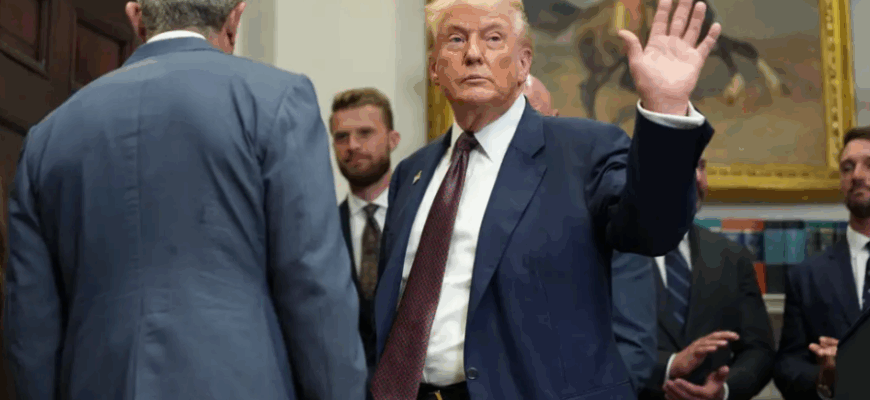On August 7, 2025, U.S. President Donald Trump dropped a bombshell: new tariffs on goods from the European Union. Starting immediately, most EU products entering the U.S. face a 15 percent duty, while steel and aluminum get slapped with a hefty 50 percent. This isn’t just a policy tweak—it’s a bold move that could reshape trade between two economic giants. For readers of TheMors, we’ve dug into the details, the reasons behind it, and what it means for Europe and the rest of the world. Our team of journalists has sifted through the noise to bring you a clear picture of this high-stakes decision.
- What’s Going On with These Tariffs?
- Breaking Down the Numbers
- Why Is Trump Doing This?
- The Bigger Picture
- How’s the EU Handling It?
- Inside the Negotiations
- What’s the Damage for Europe?
- Who’s Getting Hit Hardest?
- What About the Rest of the World?
- What Happens Next?
- Frequently Asked Questions:
- What products are hit by Trump’s tariffs?
- Why did Trump impose these tariffs?
- How’s the EU responding?
- Will prices go up in Europe?
- Could the tariffs change?
What’s Going On with These Tariffs?
Trump’s announcement came after months of back-and-forth with the EU. Speaking from Washington, he said the tariffs are about fixing what he calls “unfair trade” that’s been bleeding American jobs dry. The U.S. trade deficit with the EU—over $200 billion a year—is a sore spot for him. These new duties, effective as of August 7, cover everything from French wine to German cars, with steel and aluminum taking the biggest hit.
Breaking Down the Numbers
Here’s the deal: most EU goods now face a 15 percent tariff, down from the 30 percent Trump initially floated. Steel and aluminum, though, are stuck with a 50 percent rate, which could sting European exporters hard. Trade experts estimate this affects about $500 billion in annual EU exports to the U.S. Some products, like critical medical supplies, might get exemptions, but the details are still fuzzy.
This isn’t Trump’s first tariff rodeo. Earlier in 2025, he rolled out duties on China, Mexico, and Canada, but the EU deal came after intense talks, including a pivotal meeting with European Commission President Ursula von der Leyen in Scotland on July 27. The EU promised $600 billion in investments in the U.S. and $750 billion in energy purchases—think natural gas and oil—to keep tariffs lower than feared. Trump’s warning? If the EU doesn’t follow through, he might crank rates up to 35 percent.
Why Is Trump Doing This?
Trump’s logic is straightforward: protect American workers and shrink the trade gap. He’s long griped about the EU’s trade barriers, like their 10 percent tariff on U.S. cars compared to America’s 2.5 percent on European ones. Add in EU subsidies for farmers and manufacturers, and Trump sees a system rigged against the U.S.
But there’s more to it. This is classic Trump—using tariffs as a sledgehammer to force better deals. Earlier this year, he threatened 60 countries with tariffs, only to ease off when they played ball. The EU deal follows the same playbook: threaten big, negotiate, and settle for less. It’s part of his “America First” push to bring factories back home and cut reliance on foreign goods.
The Bigger Picture
This isn’t just about economics—it’s geopolitics. Trump’s tariffs are redrawing global trade maps. By pressuring the EU, he’s nudging them to buy more American energy, which could shift dependencies away from other suppliers. It’s a power move, but it risks sparking a trade war if talks sour.
How’s the EU Handling It?
The EU didn’t exactly roll out the red carpet for these tariffs, but they’re playing it cool—for now. Ursula von der Leyen said the bloc will hold off on retaliatory tariffs, which could’ve hit $93 billion in U.S. goods like bourbon and pickup trucks. Instead, they’re banking on diplomacy, sticking to their promises of investment and energy purchases.
Inside the Negotiations
That July meeting in Scotland was a turning point. Trump and von der Leyen hashed out a plan for zero tariffs on some U.S. exports to the EU and exemptions for certain EU goods. The European Commission is working on a joint statement, but they’re waiting for Washington’s final nod. If things go south, the EU’s ready to hit back with duties on American products.
Not everyone in the EU is on board. Germany’s freaking out—cars and machinery are their bread and butter, and these tariffs could cost billions. France and Italy want a united front to avoid looking weak. Still, the EU’s hoping to turn this into a long-term win, maybe even a full-blown trade deal.
What’s the Damage for Europe?
Let’s talk numbers. Analysts predict the tariffs could shave 0.1 to 0.2 percent off the EU’s GDP in 2025. That’s not a collapse, but for export-heavy countries like Germany or the Netherlands, it’s a headache. The automotive sector, worth €50 billion in German exports alone, will take a hit as cars get pricier in the U.S. Steel and aluminum producers in places like Poland are also in for a rough ride.
Who’s Getting Hit Hardest?
- Automotive: Brands like BMW and Volkswagen might lose market share as their cars cost more in the U.S.
- Steel and Aluminum: That 50 percent tariff could force factory layoffs in Spain and Poland.
- Chemicals and Pharma: These sectors might see a 10 percent drop in U.S. sales, though exemptions could help.
There’s a silver lining. The EU could pivot to markets like Asia or Africa for exports. Plus, buying more U.S. energy might cut reliance on less stable suppliers. Long-term, this could push European companies to innovate or bring production closer to home.
What About the Rest of the World?
Trump’s tariffs aren’t just an EU problem—they’re shaking up global trade. China’s already dealing with U.S. duties, pushing their goods to other markets, which could flood Europe with cheap products. If the EU fights back with tariffs, prices could spike worldwide, potentially slowing global growth by 0.5 percent, according to economists.
Other countries might see an opening. Russia, India, or Brazil could step in to supply the EU with raw materials or industrial goods. But the flip side is uncertainty—Trump’s trade policies are making markets jittery, and nobody likes a volatile economy.
What Happens Next?
The next few months are make-or-break. If the EU sticks to its investment and energy promises, tariffs might stay put or even drop. Trump’s hinted at a bigger trade deal, like the one he signed with the UK earlier this year, which cut tariffs on British cars. The EU’s pushing for equal treatment—zero tariffs both ways.
For European businesses, the advice is clear: diversify markets, lobby for exemptions, and brace for higher costs. For consumers, price hikes on U.S. goods like jeans or whiskey should be minimal, thanks to other suppliers stepping in. Down the road, these tariffs might force the EU to strengthen its own markets, making it less dependent on the U.S.
Frequently Asked Questions:
What products are hit by Trump’s tariffs?
Most EU goods face a 15 percent duty, with steel and aluminum at 50 percent. Some essentials, like medicines, might be exempt.
Why did Trump impose these tariffs?
He wants to cut the U.S. trade deficit and protect American jobs from what he sees as unfair EU trade rules.
How’s the EU responding?
They’ve paused retaliatory tariffs and agreed to invest $600 billion in the U.S. and buy $750 billion in energy.
Will prices go up in Europe?
U.S. goods might cost a bit more, but alternative suppliers should keep price hikes small.
Could the tariffs change?
If talks fail, tariffs could jump to 35 percent. A solid deal might lower them instead.
Hungry for more on global trade, economic shifts, or political drama? Head to TheMors – Breaking News for sharp analysis, exclusive interviews, and the latest updates. Sign up for our newsletter to stay in the loop and dive into our stories today!









